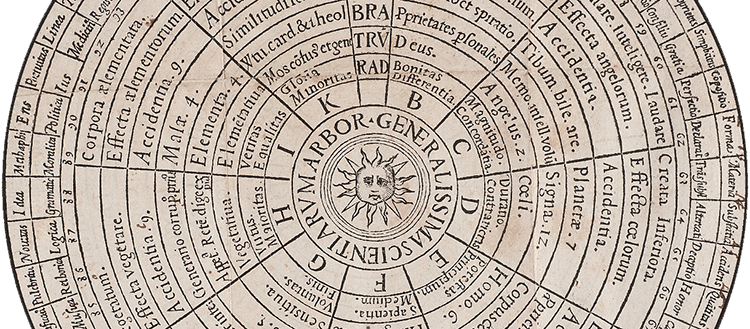How knowledge maps shape the history of science
From Plato to Piaget, a UNIGE researcher has retraced 2,500 years of history through the shifting boundaries that separate scientific disciplines.
This cardboard disk was part of a combinatorial device to inventory human knowledge, devised in the 13th century by the Majorcan scholar Ramon Llull. (Ramon Llull, Arbor Generalissima Scientiarum, Manuscript R.8363.57v (dated 1586), kept at the National Library of Spain).
When did the science of biology first appear? Is astronomy part of mathematics or empirical science? From time immemorial, humankind has attempted to inventory and systematise knowledge by building "knowledge maps". However, the boundaries between disciplines have shifted: new sciences have emerged, while others have sunk into oblivion. A researcher from the University of Geneva (UNIGE), Switzerland, has analysed how 91 scholars – from Plato to Piaget – have conceived and rewritten the inventory of human knowledge, on each occasion painting the portrait of a particular age. The research is available on a participatory website.
Mathematics has not always had the upper hand in the hierarchy of sciences. Prior to the seventeenth century, little consideration was given to the subject, with theology and philosophy occupying the top spot of human knowledge. Proof of this can be found in the discipline maps from yesteryear alongside other "trees of knowledge" that have come down to us in the form of hierarchical pyramids. These successive tree views were drawn up in different ages by the scholars themselves; they may now be found on the site designed by Raphaël Sandoz, a Postdoctoral scholar at UNIGE’s Global Studies Institute (GSI) and a specialist in the history of disciplines. The site features participatory tools that anyone can use to supplement the sources, enhance the definitions or suggest new maps. The project is the culmination of three years of research carried out in Oxford and Chicago with the support of the Swiss National Science Foundation (SNSF).
Astronomy: between observation and mathematics
Each of the knowledge maps featured on the site is accompanied not only by a bibliography referring to the sources and secondary literature but also by definitions that scholars have given of certain disciplines. A dedicated research tool can be used to follow the way in which the same discipline has been redefined over the centuries. "At the end of the sixteenth century," explains Raphaël Sandoz, "there’s a break with the English philosopher Francis Bacon. Instead of organising the sciences according to their object of study, Bacon concentrated on the mental faculties they use. He also classified the sciences according to whether they call on memory (history), imagination (poetry) or reason (philosophy, including most of the natural sciences)."
Nowadays we study celestial phenomena grouped together as one and the same science: astronomy. At the time of Francis Bacon, however, they were divided between distinct disciplinary categories. The study of the planets belonged to the realm of natural philosophy, because their orbits are regular and their movements may be predicted by human reason. The study of comets, on the other hand, fell under the rubric of natural history because of their unpredictable behaviour. Even in the nineteenth century, a distinction was made between uranology – qualitative discourse on the stars based on observation – and astronomy proper, based on mathematics and involving predictive calculations.
But when was computer science born?
Defining the date a discipline emerges is a complex exercise. Computer science, for instance, clearly did not come into being in the Middle Ages, although some mediaeval practices were already anticipating a rudimentary form of algorithmic thinking. "In the thirteenth century, the philosopher and mathematician Ramon Llull, born in Majorca, made a combinatorial device from cardboard disks. Some people describe it, probably quite inappropriately, as the forerunner of the computer", says Raphaël Sandoz. As for biology, it only appears as an autonomous life science late in the day, even though plants and animals have been studied methodically at least since Aristotle’s time as part of an essentially descriptive "natural history". It was not until the nineteenth century that a change in the discipline’s status came about, when scientists managed to identify general laws applicable to living things.
Mysterious disciplines disappeared
Conversely, some scientific disciplines have completely disappeared. In the sixteenth century, the English polymath John Dee included the following in his list of branches of knowledge: pneumatithmia (the study of how water, air, fire and smoke interact); helicosophia (the art of drawing spirals); and thaumaturgy (the scientific study of miracles). As for disciplines that are more familiar to us, they often used to be categorised in a way that surprises us today. At the beginning of the nineteenth century, another British scholar, Jeremy Bentham, classed chemistry and mechanics as "anthropurgoscopic" sciences (shaped by man), which he distinguished from natural sciences in the strict sense, which were described as "physiurgoscopic". Bentham even coined the adjective "aneunomotheticoscopic" to describe administrative disciplines.
Studying the classification of knowledge and its evolution over time helps us understand how a new discipline emerges and acquires scientific legitimacy. At the same time, it highlights the influence of disciplinary boundaries – which are constantly redrawn around the different fields of research – on the content of science. Moreover, Geneva has played an important role in this area: in the late nineteenth century, UNIGE was home to a chair devoted to the "method and classification of sciences", held by professor Adrien Naville, who made it a discipline in its own right.
30 Apr 2019
